2016 Edit: I’ve since updated my gear and wrote a new post with better information.
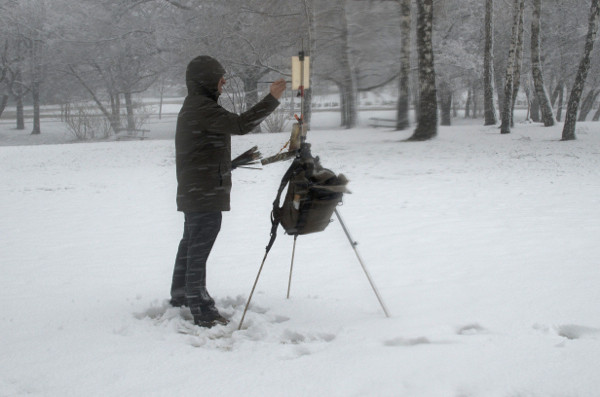
The joy of plein air painting in winter.
I love painting snow scenes outdoors in the winters, but I really, really hate being cold. I also struggle to work when I’m uncomfortable, and I believe painting is difficult enough even in the most controlled of situations.
Picking the right gear for plein air painting can be a problem as most winter outdoor gear is made for hikers or skiers/snowboarders, where the wearer will be moving a great deal. The manufacturers’ ‘minimum temperature’ is based on a much more active user than the average plein air painter, and I find that for standing still for hours in the snow means you pretty much have to double the listed temperature range on clothing. Ice-fishing and hunting forums are great places to research winter plein air gear, as they tend to have similar needs to us.
For staying really warm the key is lots of layers. Sierra Trading Post has a good guide to layering. Their interest in layers, however, is on being able to remove them when one warms up. I find I rarely remove a layer while plein air painting as I’m gradually getting colder the longer I stand still. The layering is important to me for getting warm enough in the first place. The downside with lots of layers is that movement gets harder, and for painting one doesn’t want to feel restricted in their arm movement. After painting for hours in multiple layers I get really sore shoulders.
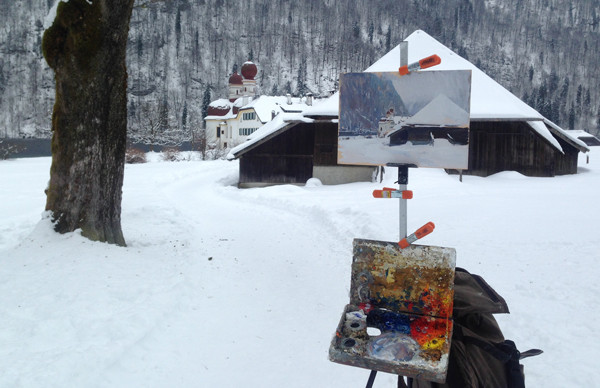
Plein air at painting St. Bartholomew’s Church, near Berchtesgaden, Germany.
The last two weeks I was painting outdoors in Austria and Bavaria in below-freezing temperatures and really suffered from the cold due to poor equipment planning on my part. I had to stop painting a couple times due to the cold, and I was often tense and stiff from standing still for hours without a proper kit on. Over the course of the trip I gradually picked up the gear I needed to work comfortably.
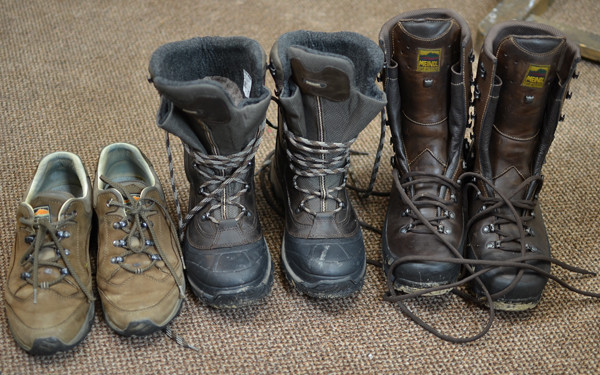
Three seasons worth of plein air painting footwear.
My old, cheap, pair of hiking boots weren’t waterproof enough for the amount of snow we found. After struggling a couple days with wet, very cold feet and trying to find some decent winter boots locally, I ended up just driving to the Meindl factory in Kirchanschöring, Bavaria, about half an hour north of where we were staying. I have a pair of Meindl hiking shoes which I’ve worn every day for a few years now and they’re still in great shape (on the left in the photo above). They were also really comfortable from day one and this trip I didn’t want to waste time breaking in new shoes. Furthermore, because of all the scouting I was doing by car, I wanted a smaller winter boot that I could wear while driving. Having a large choice at the Meindl store in the small town was perfect. In the end I picked up their Garmisch Pro GTX (in the middle in the photo above). The trade-off for being able to drive safely is that they’re not as warm as the pac boots that most winter plein air painters wear. These Meindls keep my feet warm in snow for over an hour, but after that I start to feel the cold. On the other hand, they’re such comfortable and well-made footwear that I later drove back and picked up a pair of Dovre Extreme boots (far right in the photo) for the rest of the year.
From people who know much more about standing still in cold weather, Stapleton Kearns recommends the Trans-Alaska III Pac Boot from Cabelas, and the Baffin Polar Series are recommended on ice-fishing forums. I hate the idea of buying shoes online, so I’ll look at them in stores when I’m over in Canada this August. Amazon also sells boot blankets, which get high praise from hunters, though I would think painters who stand would move too much and wear them out.
Another idea I’ve seen on ice-fishing forums is to take a piece of styrofoam to stand on to keep the shoes from touching the ice. Leo Mancini-Hresko uses the mats from his car for keeping his feet from touching the snow for the same reason. (In the photograph from 1893 posted below, Finnish painters Akseli Gallen-Kallela and Albert Edelfelt are clearly keeping their feet off the snow as well.)
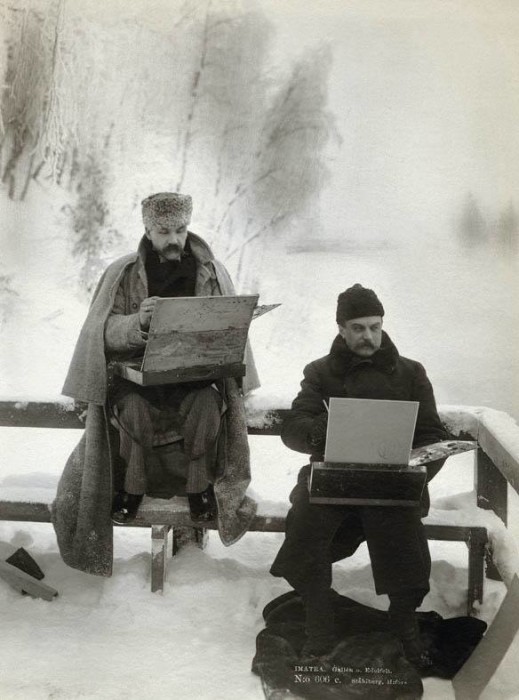
Finnish Painters Akseli Gallen-Kallela and Albert Edelfelt Painting in the Snow in 1893.
For socks I was using Salewa and Meindl merino wool hiking/hunting socks. The Salewas kept their shape better, but the Meindls were warmer. When it was really cold I put Little Hotties handwarmers in the toes of the boots and, for those times, I preferred the thinner Salewa socks. Good American sock brands I see recommend are Darn Tough and Point6. Electric, heated socks are always tempting too.
I find keeping my feet warm to be the most important thing in winter plein air painting.
For baselayer leggings, I have a pair of merino wool bottoms from Patagonia which have worked well in the past. This year I somehow forgot them while packing and could only find the synthetic ones available in the local stores. The synthetic ones supposedly work well for activities such as hiking or climbing, but for standing still they’re a disaster. I layered two pairs and still felt the cold in my legs. Winter hunting forums recommend First Lite, Ibex, or Icebreaker for merino wool baselayers. (Many are on sale at the moment, if you can find your size). In past winters I’ve always worn snowboarding shells over my regular pants and usually never had problems with cold legs.
For me, the upper body is the easiest part to keep warm. Even though my current Patagonia parka isn’t great for really cold days, I find that with enough sweaters on it works. I also have a Patagonia down ‘shirt’ (really just a lightweight down jacket) which I use as a mid-layer when it’s really cold. As I said above, wearing lots of layers makes it more difficult to move your shoulders to paint. Someday I’ll pick up a dedicated painting jacket, one that is both really warm and allows a great deal of mobility, something like the Arc’teryx Ceres, or Rab Neutrino, but I’d like to try one on before dropping that kind of money. The really warm jackets which allow great mobility get really expensive really fast. I also dislike the really bright colors that much of this gear comes in. I paint often in city centers in Europe in the winter, and I try to attract as little attention as possible while I’m working (something like this, as tempting as it is, I feel is out of the question). More importantly though, the bright colors can reflect back onto the painting while working in the sun, which affects the way one sees their colors. I find muted colors in the middle value range, or blues, are the best for shirts, sweaters and jackets.
For my hands, I find any decent winter glove works on my left hand where I hold my brushes. On this trip I was using a cheap, lightweight wool glove without problems. On my painting hand I can’t wear a glove and paint comfortably, but I find my hand gets cold after a while. My solution is to carry a Hibbard Mitten in my pocket and put it on when I feel the cold. During those periods I’ll work on areas which don’t require much precision and after a few minutes my hand is usually warm again, and stays that way for a while. When it gets cold again I rinse and repeat. If there is a wind or it is really cold I can do a whole painting wearing a Hibbard Mitten, but I prefer not to.
For my neck I wear an old cashmere scarf and never have issues with cold on my neck. A good neck-gaiter would probably be a better idea as the scarf can sometimes come lose and hit your palette. I’ve also looked into balaclavas, and will pick one up to try, though it will probably be a good idea to keep the face open while painting in cities.
Hat-wise, my wool fisherman-style hat worked fine this trip. For anything colder a fur-lined bomber hat would probably work better. Though if things get that cold I’ll probably paint from a heated car, or through the window of the hotel or house where I’m staying. When it’s snowing heavily I put the hood on my parka up and it’s designed to stick out from my face quite a bit and keep the snow off.
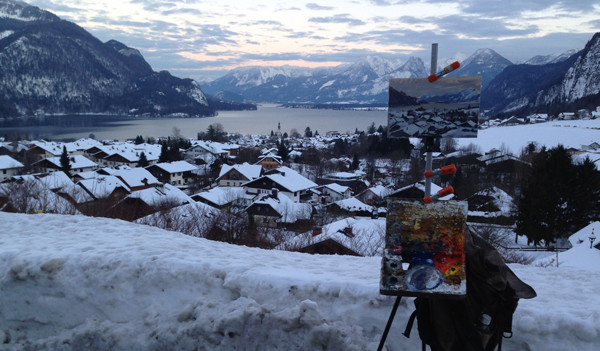
Plein air painting above St. Gilgen, Austria.
Also, when it’s snowing heavily I use an umbrella from Easyl to keep the snow off of my palette and the painting. I’d like to thank whoever left it in my car, it works great.
I’ve read that other painters have problems with their paint stiffening up with the cold. I’ve never had this issue. My Williamsburg titanium is a little bit stiffer perhaps, but nothing unmanageable. The only real difference I find painting outdoors in the snow is that I go through a lot more white and ultramarine.
If anyone else has any ideas or suggestions, I’d love to hear them. I’m still trying to figure this out.
Great article Marc. For UK based painters I can recommend a Paramo base layer top, Craghoppers Kiwi Winter trousers and Bridgedale socks.
Hi Mark;
Nice post, great paintings! I too paint outdoors. I’m in upstate NY, and it gets pretty cold and snowy here. I posted about this topic in November here is the link:
http://www.mattchinian.com/2014/11/what-i-wearwinter-gear-that-is.html
I just bought new boots and they look similar to the ones you have, but the’re Red Wings. My pack style boots were too sloppy for hiking around, and had no traction and they had holes in them, even though I don’t go very far (I always think I;d like the option to go another 100 yards!) I found foot warmers that have a sticky side so they stay put, and hand warmers that really warm up, when it’s even colder. I found my limit, and it’s basically in the single digit (fahrenheit) factoring in wind chill. The wind is really the killer. I hate umbrellas.
Thanks, Matt
What finally kept me warm and didn’t leave me feeling like a dressed up snow man was an old snow mobile or construction workers suit that I found at a thrift store for $7. These things are I think are just insulated with polyester, but they do a good job because they are just one piece and really keep the cold air out. I just put it over my street-clothes after I take my winter jacket off. Usually I put a hoodie on and a skull cap hat over the hood. I don’t even worry about if I get paint on it. They also have lots of handy pockets and you can even reach through to your inside pockets if you need to.
I see these suits for sale in discount stores for $20 – $50 in the states. If it’s really cold, I put a down vest on over the suit, which still gives me arm mobility.
My feet used to suffer until I did in fact get a pair of the moon boots. They are difficult to scout in, so I usually just put them on once I’ve settled in.The foam board is a really good Idea.
I also rely on little kid stretchy gloves, which still give me enough hand control.For me, my brush holding hand gets cold, so I often put an extra glove or mitten over that. I’m forever picking up lost gloves on the street and adding them to my collection.
The only real problem I’ve had is it’s to warm, I work up a sweat if I move to much, which of course makes you cold once you stop. It’s just a pain to paint outside in the cold! But who can resist?
My old friend Steve Gerhartz, who lives in Wisconsin, used to make camp fires in the woods,which you can get away with in a low populated place. I also met this guy in Iowa years ago who had a whole contraption set up with a metal palette and a small propane torch about 6 inches away from the bottom. Kept his paint pliable and himself warm.
Dear Marc; I just recently discovered your paintings on internet, and admire your talent. During my morning routine walk the other day, I wondered how Marc can paint in cold Salzburg when he is from LA, and thought he must really really love snow, like I do. Whiling reading your experience of painting in cold environment, I was amazed how detailed, sensible and connected you are with yourself as well as ability to express your thoughts to others which made me to think how your painting are done and it shows in your works of art/love. Your dedication/love and skill lives in your paintings. i am not a painter, but loves good paintings, yet am not rich to help those who are so talented and need. I thank you for what you do and I enjoy your art so much. Much respect from 65 years old lady who came to USA from South Korea in1975, have a 38 years old married daughter with 2 g’children. Humble bows to you! 🙂
A balaclava is great for keeping your face warm. Also snowmobile pants are nice & cozy.
My secret weapon is Stanfield Wool one piece long underwear, very soft and comfortable. .Been wearing them all my life,,,not the same pair.Couldn’t handle Alaska without them .Made in Truro Nova Scotia Around $100 and worth it. Also I mix up 95% good grade turp and 5% stand oil..put in eyeglass spray bottle ,,spray over , then cut into paint piles…20 below F,,, no problem
Marc, Thanks for the sound advice on clothing. Here on the Cape, we’ve had 3 weeks of snow. I’ve not had too much trouble with the cold but I find myself troubled by the brightness even when not directly facing the light source.. How do you handle snow blindness on clear days?
Excellent post, Marc.
May I ask where you are visiting in Canada?
I’ll be in Nova Scotia the last two weeks in August Jerry.
Canada in August, I mean.
Marc, I really enjoy checking up on your plein air work. Your draftsmanship and use of color are outstanding. I’ve learned a lot from your blog…thank you! Growing up on a ranch in NE Montana, I’ve spent a fair amount of time outside in cold temps and learning how to dress for it. So your outdoor gear article peaked my interest.
Cold is a bit of a relative term. Here, cold means below zero. Wind is what really makes things brutal. I’ve always relied on good old Carhart. It doesn’t break the bank, so if you get some paint on it you won’t feel like you’ve ruined a $500 coat. I wear Carhart bibs on my legs if it’s “cold” with long johns and jeans underneath. I wear a Carhart hooded chore coat with a down vest under that. The bibs add another layer. Plus you won’t stick out like a sore thumb wearing the drab colors of Carhart. As you said, my arms and core tend to stay warm. My hands and feet are the hardest to keep warm. I like the Arctic variety of Muck Boots with a good pair of wool socks. I’ve found a good pair of socks is the most important thing. On my head I like what we call a sheepherders hat, but really it’s called a Stormy Kromer, and a scarf around my neck if it’s quite cold. I loose gloves so often, that I never spend too much on them. Basically this is a winter cowboy outfit, but it’s be well tested and it works.
Don’t know that I will ever have the juice for painting in the snow, but love your detailed post (and your paintings). I just took a plein air workshop from a friend of yours, Joe Altwer, in Barcelona — my kinda climate. (BTW, I have a pair of Baffin boots for the snow on Mount Hood in Oregon).
marino underwear, northern outfitters gear, a good beaver hat, and heat pads in the backs of your mittens.
Pretty good down to about -25 F or so….. Then the oil paints do become a bit stiff.
The wind-chill is the common culprit here….@ -25 F and a 10 knt wind….I often make it a fairly short painting session.
Just found your blogpost as I was looking into what I might need to stay warm and do plein air painting here in Ontario. Cabela’s is in my end of town, so will be checking them out, as well as the rest of your site. Thanks!
Try doing 48″ x 60″ paintings in winter.And be there from dawn until dusk in 20 degree weather.
Hey Mark,
Just finished reading your article on winter gear for plein air painting, and I must say, it’s absolutely fantastic! As an avid plein air artist myself, I can’t tell you how much I appreciate your insightful tips and recommendations. Winter painting has always intrigued me, but I’ve been a bit hesitant to venture out into the chilly weather. However, your post has inspired me to give it a shot and embrace the magic of winter landscapes!
Your detailed breakdown of essential winter gear was incredibly helpful. I never thought about using hand warmers to keep my paint from getting too stiff or how important it is to layer up with moisture-wicking clothing. Your personal anecdotes about your experiences in different climates made the article feel so relatable and authentic. I especially loved the part about how your watercolors froze in Norway – that’s a story worth sharing with fellow artists over a warm cup of cocoa!
Thank you for being so open and sharing your knowledge, Marc. Your blog has become my go-to resource for all things plein air, and this winter gear guide is no exception. Keep up the excellent work, and I can’t wait to read more from you soon! Happy painting! 🎨